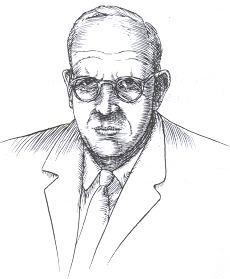The Castle Approach

Pernicious anemia was usually fatal until 1926, when Minot and Murphy first described the beneficial effects of feeding liver to those patients, suggesting that the disease was caused by a nutritional or metabolic defect. In early 1927, at age 30, W.B. Castle conceived the theory that the relation of the gastric abnormality achlorhydria to the hematologic abnormality anemia was causal. For the next 2 years, Castle directed meticulous clinical experiments to demonstrate that the gastric abnormality caused the hematologic abnormality.
He first found that oral administration of gastric juice (intrinsic factor) or beef muscle (extrinsic factor, vitamin B12) alone was ineffectual in treatment of pernicious anemia. Administration of a mixture of both, however, rendered the patient "erythropoietically active as judged by prompt reticulocyte responses and gains in red cell counts" (Castle, 1982). Castle presented preliminary data to the American Society for Clinical Investigation in 1928, concluding that "the achylia gastrica of the pernicious anemia patient is operative in the production of a deficiency causing the disease through a failure of the patient's stomach to produce the substance apparently found during digestion in the normal stomach" (Kass, 1978). That substance he later identified as intrinsic factor, which is secreted by parietal cells of the stomach and binds to vitamin B12 in the distal ilium. Others before him had appreciated that achlorhydria and anemia were associated, but no causal relationship had been demonstrated.
The son of a biologist, Castle was born in Cambridge, Massachusetts, in 1897. He attended Harvard College and graduated from Harvard Medical School in 1921. After an internship at the Massachusetts General Hospital, he spent 2 years in the physiologic laboratory of Walter B. Cannon. In 1925, at age 28, Castle returned to clinical medicine as a resident under Francis Peabody, the first director of the newly opened Thorndike Memorial Laboratory of Boston City Hospital. There Castle eventually conducted the research on pernicious anemia that distinguished him as a great physician–scientist:
I found myself fascinated with this mysterious and fatal disease but made no scientific progress over the next two years, my continued presence perhaps being tolerated because I was taking care of some of the patients on the Thorndike Ward and occasionally able to persuade a pernicious anemia patient to permit trephine biopsy of the tibial marrow for Dr. Peabody's research. (Castle, 1982)
In 1937, at age 40, he became professor of medicine of Harvard University, and in 1948, following the retirement of Minot, Castle became the third director of the Thorndike. He became the George Roberts Minot Professor of Medicine in 1957, and on retiring from his hospital administrative positions in 1963, he was appointed Francis Weld Peabody Faculty Professor of Medicine. He was honored with an appointment in 1968, at age 71, as Faculty Professor Emeritus and Distinguished Physician in the Veterans Hospital.
What also distinguishes the clinical investigation of Castle was his direct responsibility for data. He cared for the patients, carried out the assays, and monitored all procedures. Eugene Stead, who was chief resident at the Thorndike from 1937 to 1939 and later chairman of the Department of Medicine at Emory University and then Duke University, had these recollections:
William Castle was the most original thinker of my Thorndike mentors, I first met him on the steps of Burnham Building. A resident was describing the course of a patient with kidney disease and his projected treatment, I pointed out to him the error of his ways, and the resident defended himself by telling me that he was following Castle's instruction. I replied that I didn"t believe Castle knew much about this problem. I sensed without turning around that a third person had come near enough to hear this exchange. On turning around, the newcomer said, "I"m Bill Castle, and I"d like to take part in this discussion." I was, of course, very embarrassed; but not Castle. He was too secure in his good sense to be annoyed by criticism. We agreed that I knew more about this particular problem than he did. Castle was always willing to look at any critical problem, and he never felt uneasy if he did not have much specific knowledge about the problem. He could identify the problem and the points at issue. He then extracted from his colleagues what they knew and added any information that he had. Knowing the general state of knowledge and the techniques available to investigators, Castle could make a reasonable guess about the knowledge that could be obtained from the library, and various members agreed to look up the relevant paper. Knowing the state of the art, he could project the next experimental approach to unearth new knowledge. A wise man, he had defined a clinical problem, collated information from persons present at the bedside, decided on the necessary library work and projected the next clinical research on the problem—all without a complete and comprehensive knowledge of the subject. He taught me that I need not know everything to be an effective teacher. When 1 visit other hospitals, the resident is frequently surprised that I will see any type of patient in front of a large group without special preparation. The Castle approach gives me that freedom. (Stead" 1983)
References
- Castle WB. Hematology at the Thorndike. In: Finland M, ed. The Harvard medical unit at Boston City Hospital. Boston: Harvard Medical School, 1982;245–67.
- Kass L. William B. Castle and intrinsic factor. Ann Intern Med. 1978;89:983–91. [PubMed: 363011]
- Stead EA, Jr. In: Finland M, Castle WB, eds. The Harvard medical unit at Boston City Hospital. II. Boston: Harvard Medical School, 1983;332–36.
Publication Details
Author Information and Affiliations
Authors
Charles Stewart Roberts.Copyright
Publisher
Butterworths, Boston
NLM Citation
Roberts CS. The Hematopoietic System. In: Walker HK, Hall WD, Hurst JW, editors. Clinical Methods: The History, Physical, and Laboratory Examinations. 3rd edition. Boston: Butterworths; 1990.